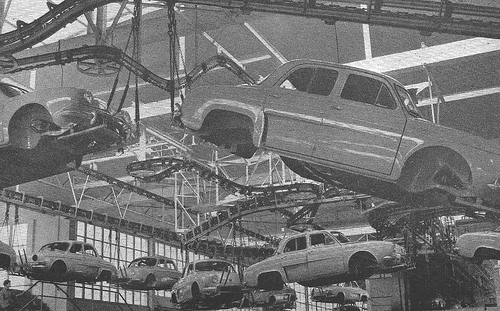This post has already been read 19587 times!
 A true demand-driven supply chain has long been the Holy Grail of automotive original equipment manufacturers (OEMs), yet even though today’s forecasts are more finely tuned, an unexpected spike or drop in demand can still wreak havoc on production schedules, market forecasts, sales plans, and supply plans. This leads to problems such as stock outs and lost sales, inventory pileups, poor capacity utilization, and declining revenues. Why hasn’t there been more progress?
A true demand-driven supply chain has long been the Holy Grail of automotive original equipment manufacturers (OEMs), yet even though today’s forecasts are more finely tuned, an unexpected spike or drop in demand can still wreak havoc on production schedules, market forecasts, sales plans, and supply plans. This leads to problems such as stock outs and lost sales, inventory pileups, poor capacity utilization, and declining revenues. Why hasn’t there been more progress?
In this post I want to explore the benefits of a demand-driven “build-to-order” strategy in the automotive supply chain and discuss the challenges to getting there. Note that this post is based on the recent white paper “Build-to-Demand: Leveraging Real-Time Data Across an Automotive Manufacturer’s Value Chain”, which I suggest you read if you want to go deeper on this issue.
Today, the dominant Automotive OEM operational model is build-to-stock (BTS). This is true in all regions of the world. The extent to which the model dominates varies by region of the world. Build-to-order (BTO) is also supported, but because of lengthy lead times, order promise reliability, and the instant gratification desires of consumers, it still represents a small percentage of overall demand. Suppliers typically build to forecast and deliver to call-offs.
Diverse and changing customer tastes and the ever-increasing pace of technology in vehicles have made mass customization a subject of great interest to many automotive OEM’s. The steady emergence of low-end vehicles into the competitive landscape has further intensified global competition for automotive consumers, accompanied by more diverse product preferences. And while competition intensifies, the accelerating pace of innovation drives a corresponding increase in frequency of newer products, and, consequently, endlessly expanding new configurations of options installed at the factory, port, or dealer.
The dynamics of global competition, long range supply chains, and product innovation produce a compounded negative impact on the ability of automotive OEMs to forecast demand and effectively position products within the dealer network. Equally challenging is the sourcing of the ever-expanding components and raw materials needed to make the products while managing the risk associated with these suppliers and channels in a highly distributed and global supply chain.
The emerging business model, and the one upon which AMR Research (Gartner) based its solution approach, is a hybrid model of build-to-stock and build-to-order. AMR has described this as “mixed-mode order fulfillment.” AMR’s view of the emerging model is is called Build to Demand. See the figure below.
In this model, the enterprise finds and continually operates at the optimal operating point between a pure build-to-stock (BTS) environment and a pure build-to-order (BTO) environment. This optimal operating point varies by model, by market, and over time. Pure BTS is undesirable because of the cost of deployed inventory and the inevitable mismatches between inventory and what customers actually want; pure BTO is undesirable because of the cost of deployed capacity required to support highly uneven demand. The optimal solution is somewhere in-between.
Yet the industry is still far too BTS-centric. Why? The following are the two biggest challenges that are preventing a greater shift toward BTO:
1. Siloed Organizations, Planning Disconnected from Execution:
The most pervasive challenges to an Automotive OEM value network are its planning and execution systems and functional organizations operating from their own silos. Silo-based processes and data within and across the value chain preclude companies from creating and managing a consistent and up-to-date picture of supply and demand due to inconsistencies and latency in the information flow. Planning and execution processes are inherently disconnected due to disparate systems and data at the department and enterprise levels. As a result, manual processes involving spreadsheets, offline business intelligent applications and email are often needed to compensate for the lack of coordinated processes and real-time information.
2. Inaccurate Forecasts:
Many automotive OEM’s operate using multiple-and often inconsistent-forecasts. For these OEM’s, forecasts are often the primary demand signal driving planning and execution across the supply network. Forecasts are frequently modified as a means to improve forecast accuracy. However, these changes propagate slowly and inconsistently throughout the supply network. When assembly plans can respond, they are often bound by constrained capacities, components, and outbound logistics. These revisions can happen many time prior to actual production and therefore trust and responsiveness becomes a real problem with the assembly plants and eventually with the component suppliers, such as power train and system. Forecasts for new products typically assume historical demand patterns from vehicles with similar attributes and options configurations. However, historical demand patterns do not necessarily reflect the current market influencers such as economic conditions, changing consumer preferences, competitive landscape, etc. Inadequate assumptions and insufficient information create forecast errors and therefore service level and inventory issues for product companies that continually introduce new products.
Image by Flickr user Hugo90
- Map of U.S. Trucking Spills in 2016 - January 13, 2017
- What is aPaaS? A Way to Supercharge Your App Development - December 12, 2016
- Future of Transportation: Goodyear’s Radical Smart Tire Concept - November 3, 2016
